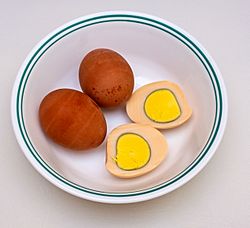Haminados facts for kids

Haminados eggs (bottom) in hamin stew
|
|
| Main ingredients | Chicken eggs |
|---|---|
Haminados, also known as chaminados or braised eggs, is a special traditional dish from the Sephardi Jewish community. It is very popular in Israel. These unique eggs are often served with other meals or as a key part of them. Haminados are especially important for the Jewish Sabbath (Shabbat) meal. They are often cooked inside a slow-cooked stew called chamin.
Contents
What are Haminados?
Haminados are usually whole eggs, still in their shells. They are often placed right on top of a slow-cooked Shabbat stew called hamin. The eggs cook very slowly for many hours, sometimes all night long! This long cooking time makes them turn a beautiful brown color.
How Haminados are Cooked
The brown eggs are called haminados. In the Ladino language, they are known as güevos haminadavos. In Spanish, they are called huevos haminados. Before serving, the eggs are peeled and placed on top of the other cooked ingredients.
In Tunisia, a country in North Africa, the brown eggs are cooked a bit differently. They are prepared separately in a metal pot on a stove that cooks all night. Water and tea leaves are added to the pot. This is similar to how tea eggs are made. You can even cook haminados this way even if you are not making a hamin stew.
Special Ingredients for Color and Texture
Adding tea leaves, coffee grounds, or even onion skins to the water does something cool. It dyes the eggshell a purple color. The egg white inside turns a light brown. This also gives the egg a super smooth and creamy texture.
How Haminados are Served
In Israel, brown eggs are a popular side dish. They are often served with ful medames, which is a dish made from mashed broad beans. You might also find them served with hummus, a tasty dip made from mashed chickpeas mixed with tahini. Haminados are also a common ingredient in a sandwich called sabich.


